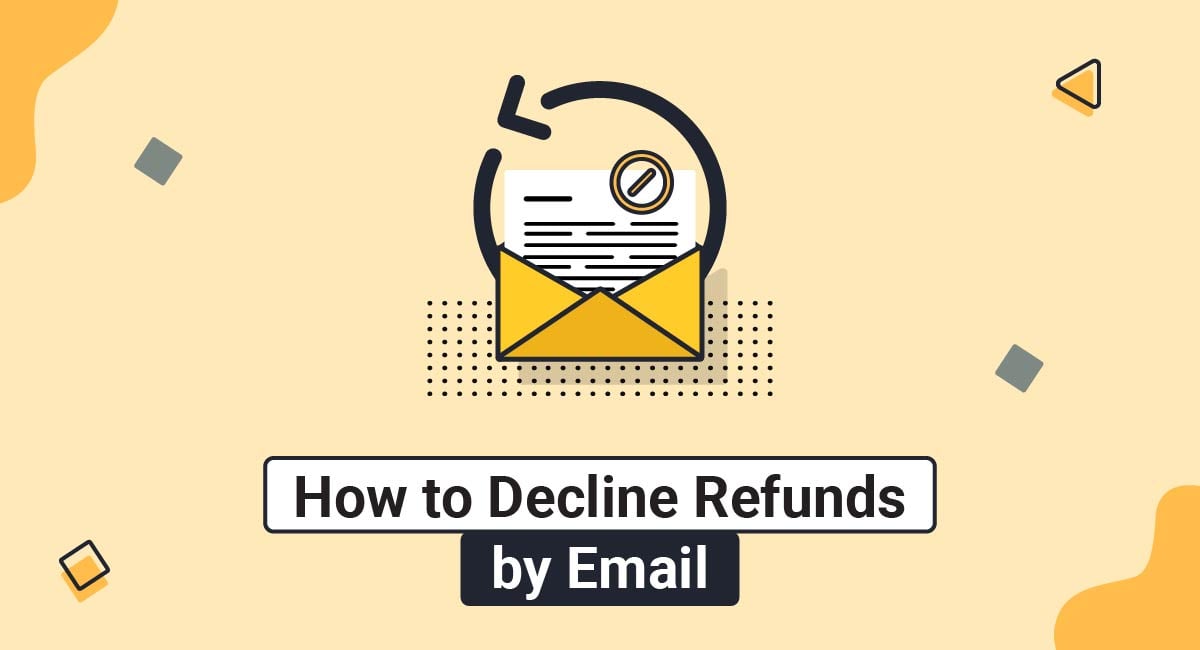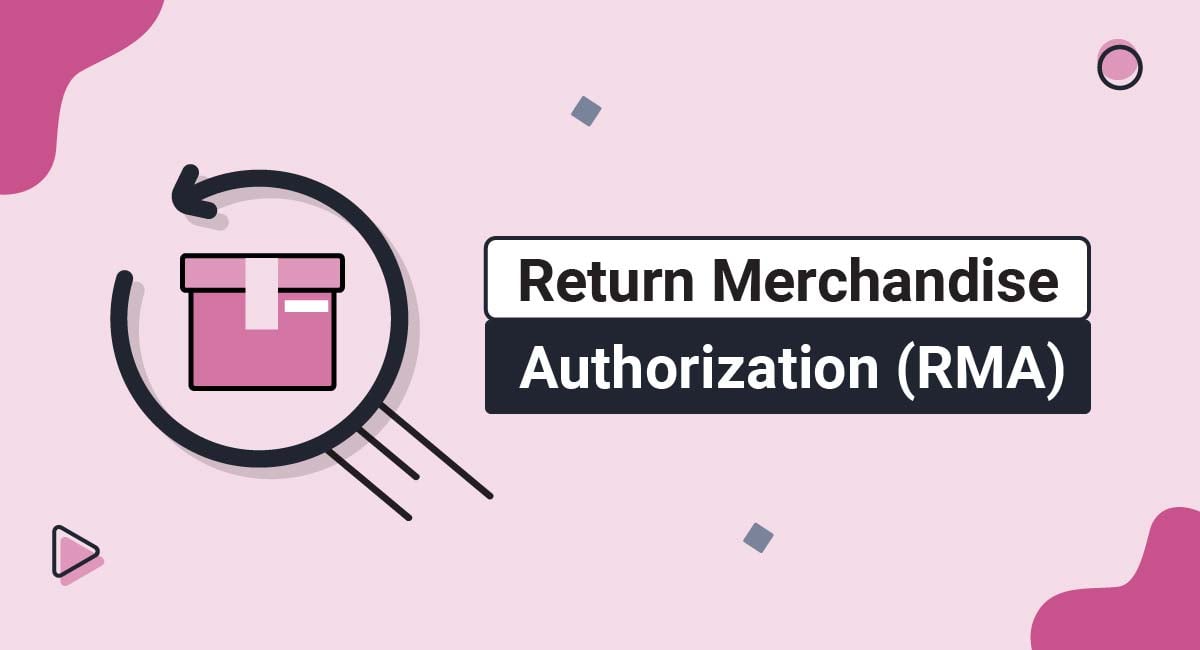If you sell products or services online, it's only a matter of time before someone requests a refund. If you wish to reserve the right to decline refund requests, there are a few things you can do to help the process go smoothly.
This article will help you understand how to best decline refunds via email, which is the most common method of communication between businesses and customers/users.
Use our Return & Refund Policy Generator to generate a Return and Refund Policy for your store. Just follow these steps:
-
At Step 1, select where your Return & Refund Policy will be used.
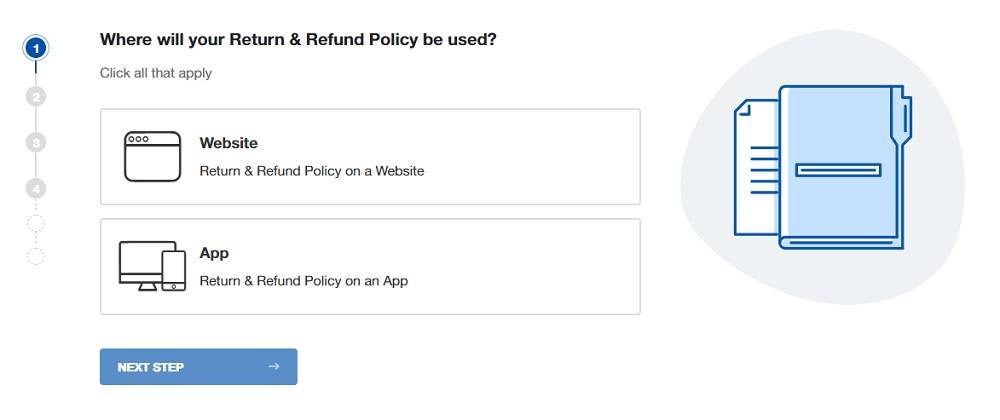
-
At Step 2, add information about your website/app and business.
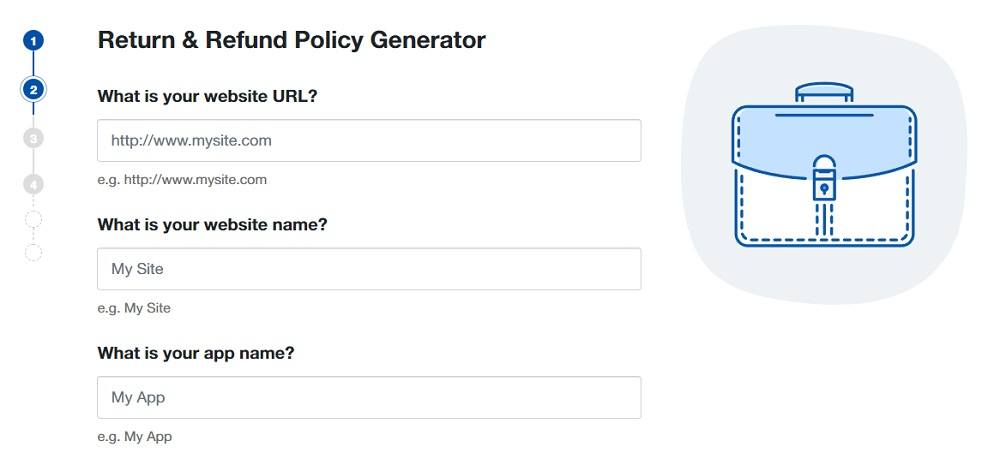
-
Answer some questions about your business practices.
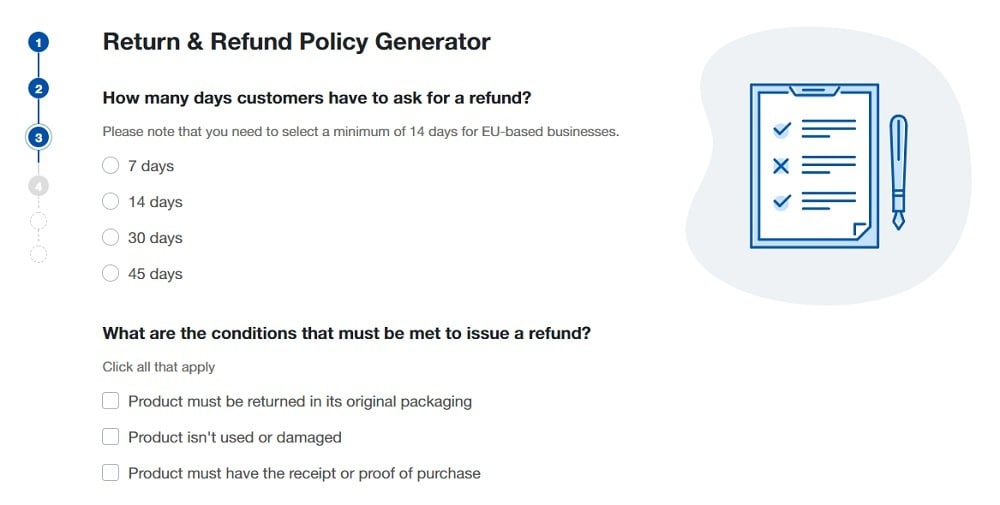
-
Enter an email address where you'd like to receive your Return and Refund Policy and click "Generate."
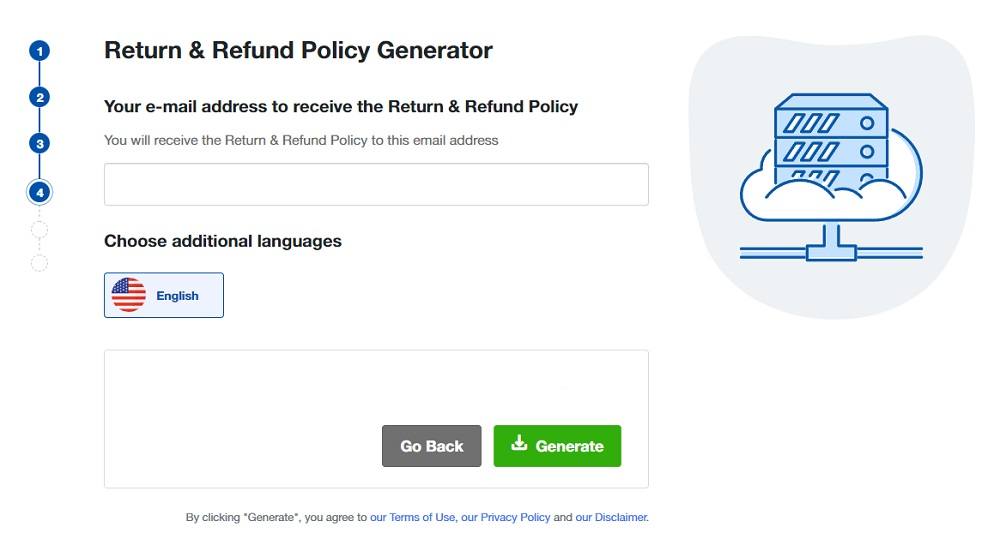
Done! You'll be able to instantly access and download your new Return and Refund Policy.
- 1. Why Should You Have a Refund Policy?
- 2. Examples of Refund Clauses
- 3. How Do You Enforce Your Refund Policy?
- 3.1. Have Clear Communication
- 3.2. Be Realistic
- 3.3. Set Fair Deadlines
- 4. How to Best Decline a Refund
- 4.1. Use company letterhead or signatures
- 4.2. Be firm and courteous
- 4.3. Express regret but remain logical
- 4.4. Thank the customer and offer appreciation
- 5. Examples of Emails Declining Refunds
- 5.1. Products returned outside a warranty
- 5.2. Discontinued products
- 5.3. Used Products
- 6. Summary
Why Should You Have a Refund Policy?
When a customer contacts you wanting a refund for a purchase, it can be an awkward experience.
This becomes especially true if you cannot issue a refund due to the condition of the returned item or your business policy on returns & refunds.
Your business needs a comprehensive Return and Refund Policy in order to set out your right to decline refunds for specific reasons (or for any reason).
When declining refunds by email, you can quickly and easily include a link to your Return and Refund Policy in the email so users can reference your policy for more answers.
Examples of Refund Clauses
Here are some examples of clauses in legal agreements that address returns and refunds, and limits on them.
Apple iTunes offers a strict Refund Policy which it maintains in its Terms & Conditions agreement. Since iTunes digital products or services, returns are not a frequent occurrence as they are with goods. This approach is more than adequate.
But the retail branch of Apple offers a separate Return Policy in the support section of its web page but this policy has nothing to do with iTunes' policy.
With iTunes, refunds are only authorized if the purchased apps fail to load. The policy also explains that if fraud or abuse is suspected, the refund will not be authorized:
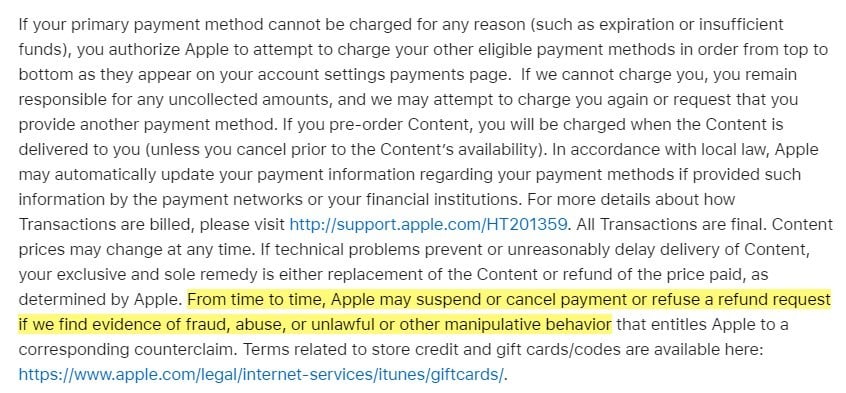
Barnes and Noble places timeframe and conditions requirements on returns and refunds. For most products, that deadline requires returns to be submitted for a refund within 30 days, and the products also need to be in new condition:

Even customizable products and in-person classes can be addressed within a Return Policy:
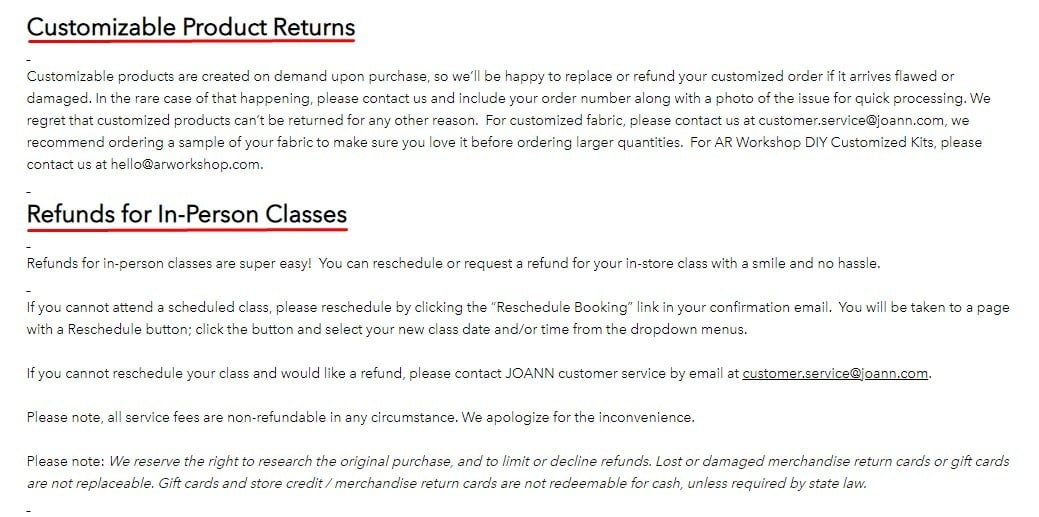
It's up to you how broad or strict you want your Return and Refund Policy to be. Just keep in mind that the policy will be a deciding factor in whether someone will purchase from you.
How Do You Enforce Your Refund Policy?
You won't be able to easily enforce your policies surrounding refunds unless you have a well-drafted, publicly-displayed Refund Policy.
You also have to make a policy that you're willing to exercise.
To allow for effective enforcement of your Return/Refund Policy, consider these guidelines:
Have Clear Communication
If you have restrictions such as final sale items or conditions for returns, be upfront about them. Likewise, if you want room to deny refunds while still being generous, put in a "We reserve the right" phrase.
While you have flexibility and freedom with how you handle returns and refunds, you do need to communicate your policies clearly.
Be Realistic
Denying all refunds and returns on sale merchandise is actually a reasonable policy. Many consumers expect that, even if they don't appreciate it.
However, if you don't allow any refunds or returns at all, it's likely you'll be appeasing many angry customers with refunds against your policy.
Rather than take a path that compromises goodwill, create a realistic refund policy that you can consistently enforce. Your customers and potential customers will favor this.
Set Fair Deadlines
A 14-day or 30-day return deadline is reasonable.
Keeping the return deadline open-ended risks having to appease customers with refunds for obviously well-used merchandise.
If you create a clear Return/Refund Policy that you can live with and enforce consistently, declining refunds becomes easier.
How to Best Decline a Refund
The best course of action when declining refunds is to explain why you are declining one.
Be concise and give specific reasons and you're less likely to lose faith or receive pushback from a customer.
Reasons for declining a refund can vary. Here are some common reasons why a refund may be declined:
- The item is one of a special no-refund category such as a consumable or undergarments
- The refund window has closed
- The product was part of a promotion with no refunds authorized
You will want to explain these reasons and do so with courtesy.
Before you write an email rejecting a refund request, consider carefully how you wish to present that correspondence.
Here are some tips:
Use company letterhead or signatures
If you have a trademark email signature or letterhead, use it to appear more official.
This will not be an informal email but one written like business correspondence.
The professionalism and voice of authority here may help customers accept the fact that they cannot have a refund.
Be firm and courteous
Start by acknowledging the refund request and your steps in determining if it was valid. Then explain your decision to deny the refund.
Use active language like, "I looked into your situation and our refund policy does not allow one in this case."
Consider indicating that you spoke to a manager to add to the authority. This also shows that you looked into this matter thoughtfully and did not reject the refund request right away.
Investigation, even when it ends in a negative conclusion, is appreciated more than uninformed or seemingly brash decision making.
Express regret but remain logical
There's no harm in indicating that you're sorry but the policy does not allow a refund in this matter. It shows empathy but also demonstrates that your hands are tied when it comes to the situation.
If there's a manufacturer's policy that voids the warranty or other items out of your control, mention them, too.
You want to give specific reasons because being vague will only contribute to frustration of the customer.
Thank the customer and offer appreciation
Appreciation can go a long way with negative news. Indicate that you're grateful for their patronage and you hope they will shop with you again.
Offer a discount for their next purchase if you have the means to do so. Even a 15 percent discount can encourage forgiveness.
Before you send the email declining a refund, proofread it carefully and check to see if you missed any policy explanations.
You want your letter to be clear, well written, and contain all applicable reasons for denying the refund.
Examples of Emails Declining Refunds
Here are a few examples of how to decline a refund through email.
Products returned outside a warranty
Products returned outside a warranty are a frequent reasons for refund refusals. You'll likely deny these refunds because you'll not get reimbursed by a manufacturer and you don't want to absorb that cost.
For this situation, try this approach:

Discontinued products
Discontinued products that people attempt to return past return deadlines is also a regular occurrence.
This example will give you ideas even if the only issue with the return request was the deadline:
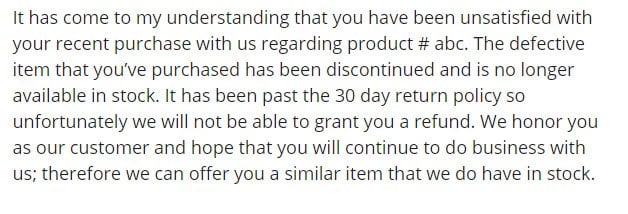
Used Products
When products are obviously used or have been tampered with, it suggests bad faith from the customer. It's apparent that a refund is not appropriate.
However, even in this tough situation, it's best to stick with facts and offer a full explanation:
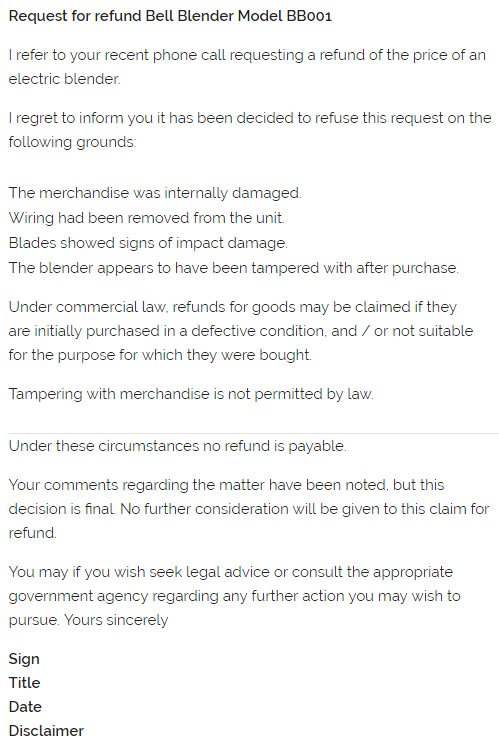
If the email exchange involved a particularly unruly customer, you can always suggest they talk to an attorney or a consumer agency. The above example reflects that possibility.
Remember that when you encounter difficult customers to keep a file of correspondence and policies in case they really do consult an attorney or file a consumer complaint.
Summary
It's in your best interest to create a good Refund Policy and enforce it consistently, especially if you wish to decline user refund requests.
Note important details like how long your return window is and how users can go about requesting a refund. Reserve your right to decline refunds at your discretion, and note any conditions of return that must be present, such as the item having original packaging or being returned within 10 days.
Let users know how to go about requesting a refund as well.
When you do decide to decline a refund request, you can do it via email by being polite, to the point, and letting the user know why you made your decision. Link to your Return and Refund Policy as well so the user can find out more detailed information about your decision.

Comprehensive compliance starts with a Privacy Policy.
Comply with the law with our agreements, policies, and consent banners. Everything is included.
